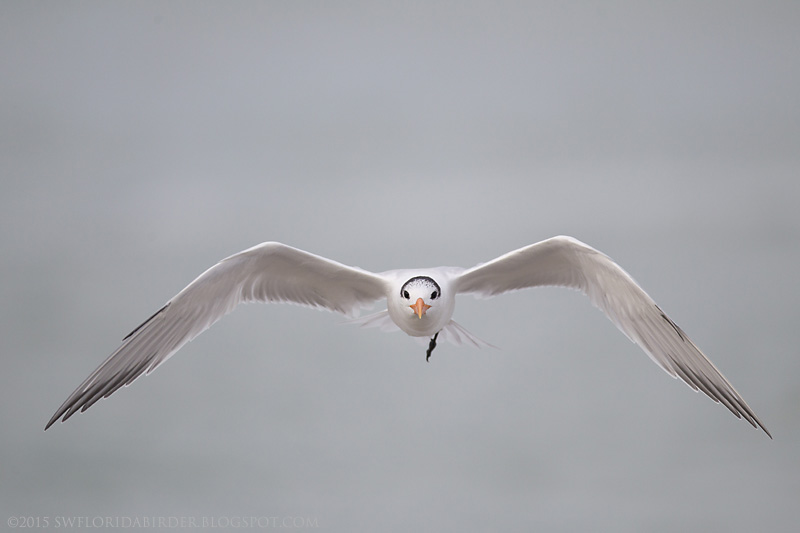An early February visit to Blind Pass was with the hope of observing Northern Gannets as reported by Lillian Stokes the previous week.
The sunrise above (image 1) was photographed at Blind Pass in February 2015.
While waiting for them unsuccessfully I was entertained by the other wildlife that was active in the noticeable wind from the east northeast. The best bird of the morning at the pass was a Bonaparte's Gull.
The Ruddy Turnstone with prey above (image 2) was photographed at Blind Pass in February 2015.
The Ruddy Turnstone above (image 3) was photographed at Blind Pass in February 2015.
The Ring-billed Gull above (image 4) was photographed at Blind Pass in February 2015.
The Ring-billed Gull above (image 5) was photographed at Blind Pass in February 2015.
The Ring-billed Gull above (image 6) was photographed at Blind Pass in February 2015.
The Double-crested Cormorant above (image 7) was photographed at Blind Pass in February 2015.
The Bonaparte's Gull above (image 8) was photographed at Blind Pass in February 2015.
When I was reviewing its images for this post, I was unsure of what it was and requested the advice of master birder, Vince McGrath. Asking Vince if this might be a Ross's Gull, he informed me otherwise noting it as a Bonaparte's Gull highlighting the bill and tail feathers as telltale characteristics.
The Bonaparte's Gull above (image 9) was photographed at Blind Pass in February 2015.
The Ring-billed Gull above (image 10) was photographed at Blind Pass in February 2015.
The Great Black-backed Gull (3rd winter) above (image 11) was photographed at Blind Pass in February 2015.
The Great Black-backed Gull (3rd winter) above (image 12) was photographed at Blind Pass in February 2015.
The Great Black-backed Gull (3rd winter) above (image 13) was photographed at Blind Pass in February 2015.
The Great Black-backed Gull (3rd winter) above (image 14) was photographed at Blind Pass in February 2015.
The Royal Tern above (image 15) was photographed at Blind Pass in February 2015.
I had previously only seen a Bonaparte's Gull on one other occasion while birding Bald Point State Park in February 2013 with Tom Obrock. The butt shot image of the gull on that trip has finally been improved upon.
The Royal Tern above (image 16) was photographed at Blind Pass in February 2015.
The Royal Tern above (image 17) was photographed at Blind Pass in February 2015.
The Ring-billed Gull above (image 18) was photographed at Blind Pass in February 2015.
The Royal Tern above (image 19) was photographed at Blind Pass in February 2015.
The Black Skimmer above (image 20) was photographed at Blind Pass in February 2015.
The Royal Tern above (image 21) was photographed at Blind Pass in February 2015.
The Ring-billed Gull above (image 22) was photographed at Blind Pass in February 2015.
As a coincidence, I had the good fortune of observing a Great Black-backed Gull for the second time as well with its previous sighting at Lovers Key State Park in either 2007 or 2008.
The Great Black-backed Gull (3rd winter) above (image 23) was photographed at Blind Pass in February 2015.
The Royal Tern above (image 24) was photographed at Blind Pass in February 2015.
The Great Black-backed Gull (3rd winter) above (image 25) was photographed at Blind Pass in February 2015.
I left Blind Pass reluctantly with my next destination Ding Darling National Wildlife Refuge.
The Ring-billed Gull above (image 26) was photographed at Blind Pass in February 2015.
The Herring Gull above (image 27) was photographed at Blind Pass in February 2015.




























Congrats on the Bonaparte's and Black-back Gulls
ReplyDeleteThanks, Tom. I will be able to immediately identify both the Bonaparte's Gull when I see one again, and with luck a Ross's Gull after reading about the species in depth. The Great Black-backed Gull at 30 inches in length was of course the "Big Bird" behind the Brown Pelican (51 inches) and Double-crested Cormorant (33 inches) seen at Blind Pass this visit.
Delete